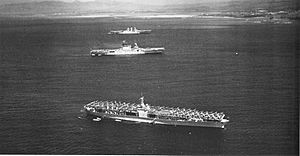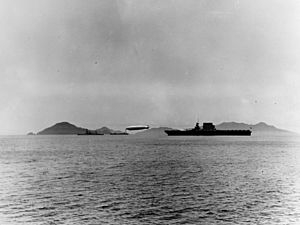Fleet problem facts for kids
The Fleet Problems were a series of big practice exercises for the United States Navy. They happened between 1923 and 1940, and then again starting around 2014. These exercises were like huge mock battles. The Navy would pretend to fight against imaginary enemy navies, often playing the part of European or Asian forces. This helped them train and test new ideas for naval warfare.
What Were the Fleet Problems?
The first 21 Fleet Problems, from I to XXI, took place almost every year between 1923 and 1940. They were the most important part of the Navy's yearly training. Each problem involved many ships and sailors. They would practice different battle situations.
Fleet Problem XXII was planned for 1941. But it was canceled because of growing tensions with Japan. These tensions soon led to the US joining World War II. After the war, the name "Fleet Problem" wasn't used for a long time. Other names were used for big naval exercises.
However, the idea was brought back in the 21st century. Admiral Scott H. Swift helped restart them. Fleet Problems XXIII through XXVIII have taken place in the Pacific Ocean since 2014.
Early Fleet Problems (1923-1940)
Fleet Problem I: Testing the Panama Canal
Fleet Problem I happened in February and March of 1923. It took place off the coast of Panama. A huge number of ships, 165 in total, and almost 40,000 sailors joined in. They came from both the East and West Coasts of the United States.
The US Battle Fleet, called the "Black Force," was the attacker. Their goal was to attack the Panama Canal. The "Blue Force," made up of ships from the East Coast, had to defend the Canal.
The Black Force launched a pretend air raid. Two battleships, USS New York and USS Oklahoma, acted like aircraft carriers. A single plane from Oklahoma dropped 10 small bombs. It "destroyed" the spillway of the Gatun Dam. This ended the exercise. Everyone thought the exercise was a big success. It showed how important air power could be.
Fleet Problems II, III, and IV: A Big Scenario
Fleet Problems II, III, and IV all happened in early 1924. They were different parts of one big practice scenario.
Fleet Problem II: Long Journeys at Sea
Fleet Problem II ran from January 2nd to 15th. It followed the Battle Fleet, the "Blue Force," as it sailed from the West Coast to Panama. This was to see how well ships could handle long trips across the ocean. During this problem, the Navy improved how ships refueled at sea. They even tried refueling side-by-side for the first time.
Fleet Problem III: Sneaky Sabotage at the Canal
In Fleet Problem III, the "Black Force" sailed from the Chesapeake Bay towards the Panama Canal from the Caribbean side. Naval forces joined with the Army for a bigger exercise. The Blue Force defended the Canal from the Black Force.
Black Fleet officers even pretended to do sabotage! One officer, Lieutenant Hamilton Bryan, landed in Panama. He pretended to be a journalist. He "detonated" fake bombs at the Gatun Locks and other important places. He also "cut" power and communication lines.
Another officer, Ensign Thomas Hederman, snuck onto USS New York. He pretended to be a sailor. He then "blew up" a bomb in the ship's magazine. This happened while the battleship was in the narrowest part of the Panama Canal. This "sank" New York and "blocked" the Canal. The Blue Force "lost" the exercise. This was also the first Fleet Problem where the real aircraft carrier USS Langley took part.
Fleet Problem IV: Attacking Islands
Fleet Problem IV happened from January 23rd to February 1st, 1924. It was like practicing an attack on Japan. The Blue Fleet was based in Panama, pretending to be US forces in the Philippines. The Black Fleet defended Puerto Rico, pretending to be Japanese defenders of Okinawa.
Black aircraft attacked Blue forces, but couldn't stop them from landing. The US Marine Corps tested new landing craft and tanks. This exercise was criticized because too many ships and forces were "imaginary" or "on paper." Later Fleet Problems used fewer imaginary forces.
Fleet Problem V: Carriers Show Their Power
Fleet Problem V ran from February 23rd to March 12th, 1925. The Black force, the attacker, included the US' first aircraft carrier, Langley. The Blue force had fewer planes, and some were imaginary.
The two fleets didn't make much contact. But Blue force submarines spotted and "attacked" the Black fleet. Langley showed how useful aircraft carriers could be. Her good performance helped speed up the building of new carriers, Lexington and Saratoga.
Fleet Problem VII: Langley Strikes Again
This problem happened in March 1927. It focused on defending the Panama Canal. The most important part was when Langley successfully launched a pretend air raid on the Panama Canal.
Fleet Problem IX: A Daring Carrier Attack
This exercise in January 1929 studied how to attack the Panama Canal. Many US Navy ships were involved. In a very bold move, Saratoga was sent away from the main fleet with only one cruiser. She made a wide sweep to the south and "attacked" the Panama Canal. The Canal was defended by the Scouting Fleet and Saratoga's sister ship, Lexington.
Saratoga successfully launched her attack. Even though she was "sunk" three times later that day, she proved that a fast task force with a carrier could be very effective.
Fleet Problem X: Air Power Changes Everything
Held in 1930 in the Caribbean. This time, Saratoga and Langley were "disabled" by a surprise attack from Lexington. This showed how quickly air power could change the outcome of a naval battle.
Fleet Problem XII: Carriers and Submarines
This problem took place in 1931, west of Central America and Panama. The Black team, attacking from the west, tried to land forces and destroy the Panama Canal. The Blue team defended with many aircraft.
Blue's two carrier groups, with Saratoga and Lexington, attacked the invasion fleets. But they failed to stop the landings and got too close to the Black fleets.
Fleet Problem XIII: The Need for More Carriers
Fleet Problem XIII started in March 1932. The Blue team, based in Hawaii, was to sail east and "invade" three enemy ports on the North American Pacific coast. Blue had nine battleships and one aircraft carrier. Black defended with one modern aircraft carrier and some imaginary battleships.
Black's submarines quickly found Blue's advance. Both sides tried to destroy the enemy aircraft carrier. They launched air attacks almost at the same time. Both carriers were "damaged." Blue's carrier was eventually "sunk" by a torpedo.
After the exercise, everyone agreed that naval aviation was becoming very important. They also realized they needed to build more aircraft carriers for a war in the Pacific. It was clear that one carrier was not enough. So, the Navy decided that two or more carriers should work together. Admiral Harry E. Yarnell said six to eight carriers would be needed for a Pacific campaign. But because of the Great Depression, new carriers were not ordered.
Fleet Problem XIV: Attacking the US Coast
Held from February 10th to 17th, 1933. This was the first naval exercise to test pretend aircraft carrier attacks against the west coast of the United States. The results were mixed. The defensive Blue fleet stopped some attacks. But the Black fleet scored key victories with attacks on San Pedro and San Francisco, California.
Fleet Problem XV: Canal Defense and Base Capture
Held in May 1934 in Hawaii. This exercise had three parts. It included an attack on and defense of the Panama Canal, capturing advanced bases, and a major fleet battle.
Fleet Problem XVI: A Big Pacific Test
Held in May 1935 off the coast of Alaska and near the Hawaiian Islands. This was the largest of these exercises. It was seen as a challenge by Japan, which then held its own big exercise.
Fleet Problem XIX: Defending Hawaii

This operation in April and May 1938 gave the Navy more experience in finding enemy ships. It also helped them use submarines, destroyers, and aircraft for scouting and attacking. The exercise also practiced taking over and defending advanced naval bases. Fleet Problem XIX also tested how well the Hawaiian Defense Force could protect the islands.
Fleet Problem XX: President Watches
Took place in February 1939 in the Caribbean and Atlantic. President Franklin D. Roosevelt watched it in person. The exercise pretended to defend the East Coast of the United States and Latin America. The Black team defended against the invading White team. A huge number of ships, planes, and sailors took part.
Fleet Problem XXI: A Smaller Exercise Before War
Problem XXI was smaller than most. World War II had already started in Europe. The US Navy was busy with "Neutrality Patrols" in the Atlantic Ocean. Over 60 warships were doing these patrols. This meant fewer ships could join Fleet Problem XXI, which ran from April 1st to May 17th, 1940.
Just days after Fleet Problem XXI ended, the fleet was ordered to stay in Hawaii. This was to act as a warning to Japan, which was becoming more aggressive. Admiral James O. Richardson, the Commander in Chief, protested this. He said the fleet would be open to air attack, just like the Fleet Problems had shown. After months of disagreeing, Admiral Richardson was removed from his job. The fleet stayed in Hawaii. It was attacked by Japanese air forces on December 7th, 1941.
Fleet Problem XXII: Canceled Due to Rising Tensions
Fleet Problem XXII was planned for 1941. But by December 3rd, 1940, Chief of Naval Operations Admiral Harold Rainsford Stark canceled it. The global situation was getting worse. The cancellation was so important that it made the front page of the New York Times.
21st Century Fleet Problems
Fleet Problem XXIII: The Revival
Fleet Problem XXIII was the first to happen in the 21st century. Admiral Scott H. Swift and the US Pacific Fleet brought the idea back. It focused on Carrier Strike Group One, led by the aircraft carrier USS Carl Vinson.
Details about these recent Fleet Problems are not widely public. However, the US Navy did share that one Fleet Problem in 2021 included many unmanned vehicles. These were controlled from a Zumwalt-class destroyer. This shows how the Navy is using new technology in its training.
|



